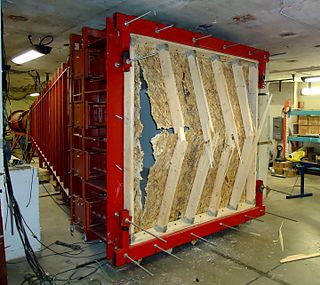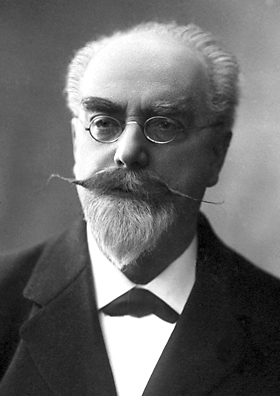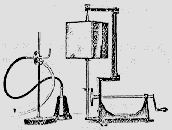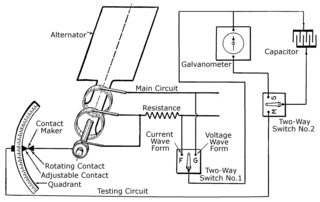
The stethoscope is a medical device for auscultation, or listening to internal sounds of an animal or human body. It typically has a small disc-shaped resonator that is placed against the skin, with either one or two tubes connected to two earpieces. A stethoscope can be used to listen to the sounds made by the heart, lungs or intestines, as well as blood flow in arteries and veins. In combination with a manual sphygmomanometer, it is commonly used when measuring blood pressure.

A loudspeaker is an electroacoustic transducer that converts an electrical audio signal into a corresponding sound. A speaker system, also often simply referred to as a speaker or loudspeaker, comprises one or more such speaker drivers, an enclosure, and electrical connections possibly including a crossover network. The speaker driver can be viewed as a linear motor attached to a diaphragm which couples that motor's movement to motion of air, that is, sound. An audio signal, typically from a microphone, recording, or radio broadcast, is amplified electronically to a power level capable of driving that motor in order to reproduce the sound corresponding to the original unamplified electronic signal. This is thus the opposite function to the microphone; indeed the dynamic speaker driver, by far the most common type, is a linear motor in the same basic configuration as the dynamic microphone which uses such a motor in reverse, as a generator.

A microphone, colloquially called a mic, is a transducer that converts sound into an electrical signal. Microphones are used in many applications such as telephones, hearing aids, public address systems for concert halls and public events, motion picture production, live and recorded audio engineering, sound recording, two-way radios, megaphones, and radio and television broadcasting. They are also used in computers and other electronic devices, such as mobile phones, for recording sounds, speech recognition, VoIP, and other purposes, such as ultrasonic sensors or knock sensors.

Holography is a technique that enables a wavefront to be recorded and later reconstructed. It is best known as a method of generating real three-dimensional images, but also has a wide range of other applications. In principle, it is possible to make a hologram for any type of wave.

The Michelson–Morley experiment was an attempt to measure the relative motion of the Earth and the luminiferous aether, a supposed medium permeating space that was thought to be the carrier of light waves. The experiment was performed between April and July 1887 by American physicists Albert A. Michelson and Edward W. Morley at what is now Case Western Reserve University in Cleveland, Ohio, and published in November of the same year.

Karl Rudolph Koenig was born in Königsberg of Prussia. Koenig was a businessman, instrument maker, and German physicist, chiefly concerned with acoustic phenomena. He was best known for designing and building acoustical instruments such as the tuning fork and sound analyser.

Dayton Clarence Miller was an American physicist, astronomer, acoustician, and accomplished amateur flautist. An early experimenter of X-rays, Miller was an advocate of aether theory and absolute space and an opponent of Albert Einstein's theory of relativity.

The phonautograph is the earliest known device for recording sound. Previously, tracings had been obtained of the sound-producing vibratory motions of tuning forks and other objects by physical contact with them, but not of actual sound waves as they propagated through air or other mediums. Invented by Frenchman Édouard-Léon Scott de Martinville, it was patented on March 25, 1857. It transcribed sound waves as undulations or other deviations in a line traced on smoke-blackened paper or glass. Scott believed that future technology would allow the traces to be deciphered as a kind of "natural stenography". Intended as a laboratory instrument for the study of acoustics, it was used to visually study and measure the amplitude envelopes and waveforms of speech and other sounds, or to determine the frequency of a given musical pitch by comparison with a simultaneously recorded reference frequency.

The shock tube is an instrument used to replicate and direct blast waves at a sensor or a model in order to simulate actual explosions and their effects, usually on a smaller scale. Shock tubes can also be used to study aerodynamic flow under a wide range of temperatures and pressures that are difficult to obtain in other types of testing facilities. Shock tubes are also used to investigate compressible flow phenomena and gas phase combustion reactions. More recently, shock tubes have been used in biomedical research to study how biological specimens are affected by blast waves.
In the field of acoustics, a diaphragm is a transducer intended to inter-convert mechanical vibrations to sounds, or vice versa. It is commonly constructed of a thin membrane or sheet of various materials, suspended at its edges. The varying air pressure of sound waves imparts mechanical vibrations to the diaphragm which can then be converted to some other type of signal; examples of this type of diaphragm are found in microphones and the human eardrum. Conversely a diaphragm vibrated by a source of energy beats against the air, creating sound waves. Examples of this type of diaphragm are loudspeaker cones and earphone diaphragms and are found in air horns.
Musical acoustics or music acoustics is a multidisciplinary field that combines knowledge from physics, psychophysics, organology, physiology, music theory, ethnomusicology, signal processing and instrument building, among other disciplines. As a branch of acoustics, it is concerned with researching and describing the physics of music – how sounds are employed to make music. Examples of areas of study are the function of musical instruments, the human voice, computer analysis of melody, and in the clinical use of music in music therapy.

The Stroh violin or Stroviol is a type of stringed musical instrument that is mechanically amplified by a metal resonator and horn attached to its body. The name Stroviol refers to a violin, but other instruments have been modified with the amplification device, including the viola, cello, double bass, ukulele, mandolin, and guitar. Johannes Matthias Augustus Stroh, an electrical engineer from Frankfurt, invented the instrument in London in 1899.

Jonas Ferdinand Gabriel Lippmann was a Franco-Luxembourgish physicist and inventor, and Nobel laureate in physics for his method of reproducing colours photographically based on the phenomenon of interference. His parents were French Jews.

Sound recording and reproduction is the electrical, mechanical, electronic, or digital inscription and re-creation of sound waves, such as spoken voice, singing, instrumental music, or sound effects. The two main classes of sound recording technology are analog recording and digital recording.

Wheeler's delayed-choice experiment describes a family of thought experiments in quantum physics proposed by John Archibald Wheeler, with the most prominent among them appearing in 1978 and 1984. These experiments are attempts to decide whether light somehow "senses" the experimental apparatus in the double-slit experiment it travels through, adjusting its behavior to fit by assuming an appropriate determinate state, or whether light remains in an indeterminate state, exhibiting both wave-like and particle-like behavior until measured.
The history of sound recording - which has progressed in waves, driven by the invention and commercial introduction of new technologies — can be roughly divided into four main periods:

Koenig's manometric flame apparatus was a laboratory instrument invented in 1862 by the German physicist Rudolph Koenig, and used to visualize sound waves. It was the nearest equivalent of the modern oscilloscope in the late nineteenth and early twentieth centuries.

Johann Heinrich Scheibler was a silk manufacturer from Crefeld, Prussia, without a scientific background, who went on to make contributions to the science of acoustics as a self taught musicologist. He made a "tonometer" from 56 tuning forks as an instrument for accurately measuring pitch by counting beating, described in 1834. "A wooden board...together with a small wooden mallet with which the forks are to be struck, and a good metronome, constitute Scheibler's tuning apparatus."
'The physical and musical Tonometer, which makes evident to the eye, by means of the pendulum [metronome], the absolute vibrations of the tones, and of the principal kinds of combinational tones, as well as the most precise exactness of equally tempered and mathematical chords, invented and executed by Heinrich Scheibler, silk manufacturer in Crefeld.'

The history of the oscilloscope was fundamental to science because an oscilloscope is a device for viewing waveform oscillations, as of electrical voltage or current, in order to measure frequency and other wave characteristics. This was important in developing electromagnetic theory. The first recordings of waveforms were with a galvanometer coupled to a mechanical drawing system dating from the second decade of the 19th century. The modern day digital oscilloscope is a consequence of multiple generations of development of the oscillograph, cathode-ray tubes, analog oscilloscopes, and digital electronics.

Frank Rieber was a pioneering geophysicist, entrepreneur, inventor, and innovator, and made advances in a variety of fields. He is particularly remembered for his groundbreaking research in automated seismic data processing, decades before the industry performed similar research. His patents related to reproducible seismograms would lead to the ability to better locate petroleum, and gain widespread use and recognition by improving the fidelity of seismographs in accurately depicting underground rock strata and oil structures, particularly in areas with complex geological formations.















